|
Working
Fluid
|
|
|
For
High Temperature Applications
|
Sodium,
Potassium, Mercury
|
|
For
Low Temperature Applications
|
Benzene,
Freon (Organic Fluids)
|
|
Low
Cost, Availability, High Enthalpy of Vaporization
|
Steam
|
Fuel Type
Coal, nuclear, geothermal
or natural gas.
|
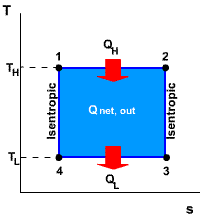 |
||||||||
Rankine cycle is the ideal cycle for vapor power plants. It does not involve
any internal irreversibilities and consists of the following four processes:
|
Process
1-2
|
Isentropic Compression in a Pump | |
|
Process
2-3
|
Constant-Pressure Heat Addition in a Boiler | |
|
Process
3-4
|
Isentropic Expansion in a Turbine | |
|
Process
4-1
|
Constant-Pressure Heat Rejection in a Condenser |
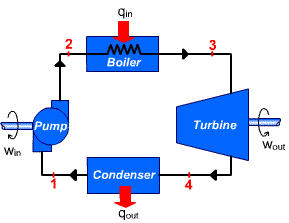 |
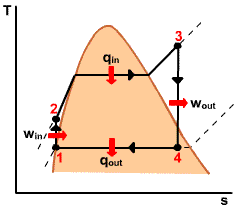 |
|
|
State
1
|
Saturated Liquid | |
|
State
2
|
Compressed Liquid | |
|
State
3
|
Superheated/Saturated Vapor | |
|
State
4
|
Saturated Liquid-Vapor Mixture with a High Quality |
|
Steady-Flow
Process
|
||||
|
Energy
Equation |
OR
|
|
||
|
Pump
|
q=0,
|
|
|
Boiler
|
w=0, |
|
|
Turbine
|
q=0,
|
|
|
Condenser
|
w=0, |
|
Thermal
Efficiency
|
||
|
|
||
|
Back
Work Ratio (BWR)
|
||
|
|
||
Fluid friction causes
pressure drops in the boiler, the condenser, and the piping between
various components. To compensate for these pressure drops, the
water must be pumped to a sufficiently higher pressure than the
ideal cycle calls for.
|
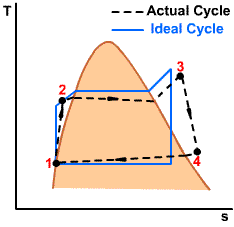 |
|||||||||||||
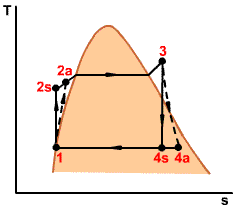 |
||||||||||||||
Basic idea to increase the thermal efficiency of a power cycle:
Increase the average temperature at which heat is transferred to the working fluid in the boiler, and decrease the average temperature at which heat is rejected from the working fluid in the condenser.
|
Three
Ways to Increase the Efficiency of the Rankine Cycle
|
||
|
Method
1
|
Method
2
|
Method
3
|
|
Lowering
the condenser pressure : |
Superheating
the steam to high temperature : |
Increasing
the boiler pressure: |
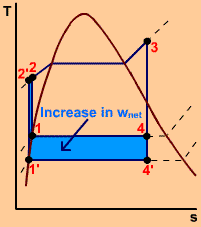 |
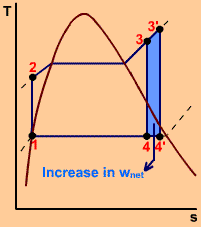 |
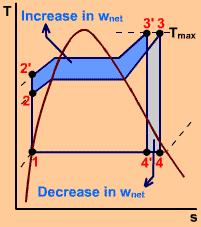
|
Operating Pressure of Boilers:
2.7 MPa (400 psia) in 1922 to over 30 MPa (4500 psia) today
Supercritical Rankine Cycle : Supercritical Pressure
|
Plants
|
Efficiency
(
|
|
|
Fossil-Fuel
Plants
|
40%
|
|
|
Nuclear
Plants
|
34%
|